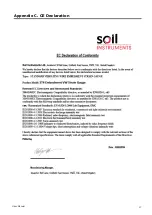
User Manual
15
Appendix A.
Vibrating Wire Data
Frequency Units (f):
The tension of a wire can be measured by registering the frequency (note) at which
it naturally vibrates. If the wire is "plucked" electronically the frequency at which it vibrates can be
measured. The most common units used to express frequency are Hertz (Hz) or Kilohertz (KHz).
The disadvantage of these units is that there is no "linear" conversion from Hertz to "change in wire
tension".
Linear Units (L):
In order to overcome the problem of a linear conversion described above, the frequency
value can be squared, thereby rendering it linear, but quite large. To reduce its size it is often divided by
1000 (or multiplied by 10
-3
). The expression f²/1000 (or f² x 10
-3
) is the most commonly adopted as a
"linear" digital output.
Period Units (P):
Electronic devices and digital technology often utilise the "counter" function available in
some common circuits.
Period Units represent the time taken for the wire to vibrate over one full oscillation, expressed in seconds.
Due to the very small size of the number generated most equipment manufacturers display the unit
multiplied by 10000000 (or 10
-7
).
The relationship between Period Units and frequency units is expressed as P µ 1
Frequency
Period units are, therefore, convenient to measure but do not have a linear relationship to "change in wire
tension".
Calibration Constants:
Each instrument is supplied with a Calibration Constant value, to convert the raw
data into engineering units.
The value of the calibration constant will vary depending upon the engineering units into which the data is to
be converted and the readout units. For example, the data from piezometers may convert into Kg/cm²,
mH20, Bar, Psi, etc., and, therefore, the Calibration Constant for each will be different.
Some instruments have "Generic" Calibration Constants and others are calibrated to generate the Constant.
The constant is generated by using the following calculation.
Constant (K) = Range
Reading @ Full Range - Reading @ Range Zero x 10
4
Summary of Contents for 1030
Page 17: ...User Manual 17 Appendix C CE Declaration ...
Page 18: ...User Manual 18 ...
Page 19: ...User Manual 19 ...






































